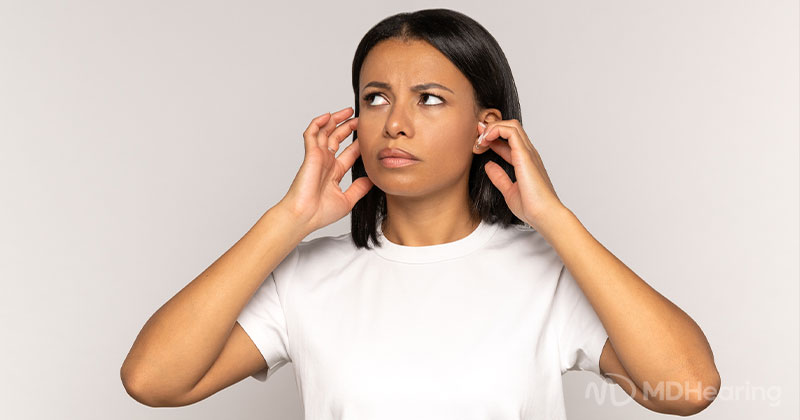Hearing aids can help dramatically improve the quality of life for millions of people. According to the U.S. National Institutes of Health (NIH), there are nearly 29 million people in the United States who could benefit from wearing hearing aids. A study by Vanderbilt University has found that 78 percent of people with hearing loss who used hearing aids were satisfied with their hearing—more than twice the satisfaction rate (36 percent) of non-hearing aid owners with hearing loss.
Despite the many benefits of hearing aids, wearing these devices can take some adjustment for new users. One unexpected consequence of hearing aids for some people is an acoustic issue known as the “occlusion effect.” This article will go over hearing aids and the occlusion effect, including what it is, why it happens, and how you can resolve it.
What is the Occlusion Effect?
The “occlusion effect” is an auditory phenomenon that occurs when an object partially or completely blocks (occludes) a person’s outer ear canal. As a result of this blockage, the person hears lower sound frequencies more loudly. This is often described as an echo, boom, or “hollow” effect that alters noises coming from one’s own body—such as chewing, footsteps, and even the sound of one’s own voice.
It’s important to note that the occlusion effect only pertains to low-frequency noises that individuals create themselves. Noises generated by other people or external forces are perceived by the individual relatively normally.
Why Does the Occlusion Effect Happen?
Low-frequency sounds from inside the body normally exit the ear canal. But when an object is inside the ear, these sounds are instead “trapped”, reflected back, and therefore amplified and perceived as louder than they normally are—which can understandably be bothersome for affected individuals.
The occlusion effect can occur due to the presence of any foreign object in the ear canal—including earphones, headsets, earplugs, and even your own fingers. However, this issue is frequently discussed in the context of people who wear hearing aids.
Hearing Aids and the Occlusion Effect
Hearing aids are one of the main causes of the occlusion effect. There are several types of hearing aids, but all of them involve placing some kind of object inside the ear canal. These objects generally come in two forms: earmolds and domes (such as MDHearing’s ComfortTIPs).
-
An earmold is a small acrylic or silicone piece that is molded to fit the wearer’s ear canal, providing a snug fit. Earmolds typically have tiny holes to provide some degree of ventilation.
-
Domes are small, silicone, cone-shaped items that, unlike earmolds, do not provide a custom fit. The openings on a hearing aid dome are sometimes larger, allowing for more ventilation and natural sound.
Depending on how tight the earmold or dome is, the device is said to be either “open-fit” or “closed-fit”:
-
Open-fit hearing aids are designed to keep the ear canal more open, allowing more sound to pass through them. This offers a more natural listening experience; however, these devices can suffer from feedback depending on the level of hearing loss.
-
Closed-fit hearing aids are designed to provide a tight seal around the wearer’s ear canal. This is often beneficial for people with more severe hearing loss, but these devices can suffer from greater occlusion effect issues.
While the occlusion effect is more common with closed-fit hearing aids that are placed tightly inside the canal, any type of hearing aid can cause the occlusion effect. The effect is particularly common for first-time hearing aid users, as well as people who have started wearing new hearing aid devices.
How to Resolve the Occlusion Effect
The good news is there are ways for hearing aid users to lessen or even resolve the occlusion effect. If you’re experiencing the occlusion effect with your hearing aids, follow the advice below:
-
Take some time: Wearing hearing aids for the first time can be an adjustment in many respects, from wearing hearing aids with glasses to traveling with hearing aids. It can take some time to get comfortable with your new hearing aids, including getting used to the occlusion effect. For many people, the occlusion effect will go away in roughly one to two weeks with daily hearing aid use.
-
Accustom yourself: Wearing your hearing aids every day will help your brain get used to the new hearing experience. If the occlusion effect is pronounced when you speak, for example, then you can read a book out loud every day so that your brain adjusts to the new sound of your voice.
-
Change your hearing aid: As discussed above, the type of hearing aid you choose has an impact on how strong the occlusion effect will be. Open-fit hearing aids with larger vents or hollow earmolds can help reduce the occlusion effect. By providing space for low-frequency sounds to escape, hearing aids with larger vents can help provide a more natural listening experience.
-
Visit a professional: If the occlusion effect has lasted for an extended period of time, it’s a good idea to visit a hearing clinic or speak with qualified audiologists and hearing professionals who can help.
MDHearing: Affordable Hearing Aids Online
The occlusion effect can have a significant impact on the listening experience of people with hearing aids. Fortunately, not only does the effect tend to lessen over time, there are certain hearing aid models that are more effective at reducing or eliminating the effect.
When looking to buy affordable hearing aids online, it’s important to find a hearing aid provider that offers trial periods and free refunds. MDHearing offers a 45-day risk-free guarantee—allowing you to test your new hearing aids, and ensure your satisfaction before committing long-term.
MDHearing has provided over 1 million affordable hearing aids to customers since we were founded by a Chicago ENT (ear, nose, throat) doctor more than a decade ago. We cut out the middleman by shipping FDA-registered OTC hearing aids straight to your doorstep without the need for a prescription. This allows us to offer high-quality hearing aids at prices that are significantly lower than the national average.
If you have questions or need support, MDHearing’s U.S.-based team of audiologists and licensed hearing aid specialists are available via phone, email, and video call.
Ready to see if MDHearing is right for you? Get started with our free, quick, and easy online hearing test.
TAKE ONLINE HEARING TEST

